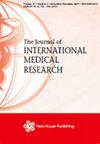CCT5 表达增加是促进鼻咽癌生长的潜在不利因素
IF 1.4
4区 医学
Q4 MEDICINE, RESEARCH & EXPERIMENTAL
引用次数: 0
摘要
目的含伴侣素TCP1亚基5(CCT5)编码含伴侣素TCP-1(CCT/TRiC)复合物的CCT5蛋白亚基,并在肿瘤发病机制中被证明是上调的。研究旨在调查鼻咽癌(NPC)和非癌性鼻咽组织中 CCT5 的差异表达,以及 CCT5 表达与鼻咽癌患者临床病理参数/预后之间的相关性。通过定量反转录聚合酶链反应(qRT-PCR)和免疫组化法测定鼻咽癌和非癌鼻咽组织中 CCT5 的 mRNA 和蛋白质水平。对鼻咽癌中 CCT5 的表达、临床参数和预后之间的关系进行了统计分析。使用EdU和细胞计数试剂盒-8评估了CCT5介导的细胞增殖。结果微阵列数据显示,鼻咽癌组织与非癌组织相比,CCT5水平显著升高,qRT-PCR和免疫组化检测证实了这一点。CCT5蛋白水平的升高与肿瘤大小、肿瘤复发和临床分期呈正相关,与患者的总生存率呈反相关。多变量 Cox 回归分析显示,CCT5 蛋白表达增强是鼻咽癌患者的一个独立预后因素。CCT5的过表达明显诱导鼻咽癌细胞增殖。结论CCT5的增加可能是促进鼻咽癌生长的不利因素。PARK2与CCT5的结合与CCT5的降解有关,这表明PARK2是鼻咽癌的上游负调控因子。本文章由计算机程序翻译,如有差异,请以英文原文为准。
Increased CCT5 expression is a potential unfavourable factor promoting the growth of nasopharyngeal carcinoma
ObjectiveChaperonin containing TCP1 subunit 5 ( CCT5) encodes the CCT5 protein subunit of chaperonin-containing TCP-1 (CCT/TRiC) complex, and is shown to be upregulated in tumour pathogenesis. The study aim was to investigate the differential expression of CCT5 between nasopharyngeal carcinoma (NPC) and noncancerous nasopharyngeal tissues, and the correlation between CCT5 expression and clinicopathological parameters/prognosis in patients with NPC.MethodsMicroarray assay data were evaluated for differential expression between NPC and noncancerous nasopharyngeal tissues. CCT5 expression in NPC and noncancerous nasopharyngeal tissues was determined at mRNA and protein levels by quantitative reverse transcription–polymerase chain reaction (qRT–PCR) and immunohistochemistry. Relationships between CCT5 expression in NPC, clinical parameters, and prognosis were statistically analysed. CCT5-mediated cell proliferation was assessed using EdU and cell counting kit-8. Western blot and co-immunoprecipitation were utilized to explore E3 ubiquitin-protein ligase parkin (PARK2)-induced degradation of CCT5.ResultsMicroarray data showed CCT5 levels to be significantly increased in NPC versus noncancerous nasopharyngeal tissues, which was confirmed by qRT-PCR and immunohistochemical assays. Increased CCT5 protein levels positively correlated with tumour size, tumour recurrence, and clinical stage, and inversely correlated with patient’s overall survival. Multivariate Cox regression analysis showed that enhanced CCT5 protein expression is an independent prognostic factor for patients with NPC. Overexpression of CCT5 markedly induced NPC cell proliferation. Finally, PARK2, as a suppressive E3 ubiquitin-ligase enzyme, was shown to bind CCT5 and induce degradation in NPC.ConclusionsIncreased CCT5 may be an unfavourable factor promoting NPC growth. Binding of PARK2 to CCT5 was associated with CCT5 degradation, suggesting that PARK2 is an upstream negative modulator in NPC.
求助全文
通过发布文献求助,成功后即可免费获取论文全文。
去求助
来源期刊
CiteScore
3.20
自引率
0.00%
发文量
555
审稿时长
1 months
期刊介绍:
_Journal of International Medical Research_ is a leading international journal for rapid publication of original medical, pre-clinical and clinical research, reviews, preliminary and pilot studies on a page charge basis.
As a service to authors, every article accepted by peer review will be given a full technical edit to make papers as accessible and readable to the international medical community as rapidly as possible.
Once the technical edit queries have been answered to the satisfaction of the journal, the paper will be published and made available freely to everyone under a creative commons licence.
Symposium proceedings, summaries of presentations or collections of medical, pre-clinical or clinical data on a specific topic are welcome for publication as supplements.
Print ISSN: 0300-0605

 求助内容:
求助内容: 应助结果提醒方式:
应助结果提醒方式:


